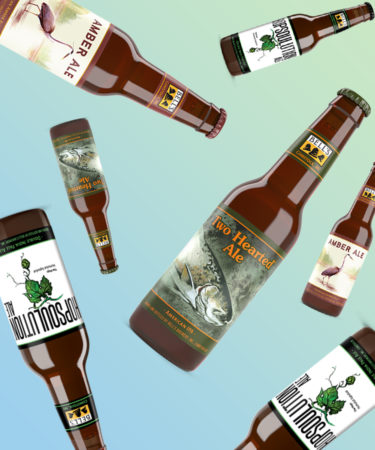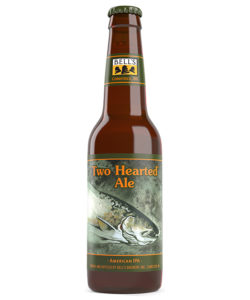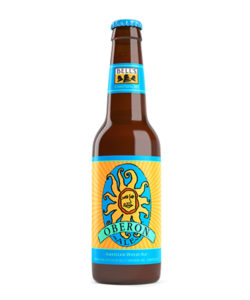The longest-running craft brewery east of the Mississippi may also be one of the most eccentric. Bell’s Brewery, which first opened in Kalamazoo, Mich., in 1985, appreciates uniqueness, both in beer and in people. And while it isn’t afraid to experiment, it’s also set the standard when it comes to flagship brands and seasonal releases.
With such legendary brews as Hopslam Ale (an early sought-ever double IPA), Oberon Ale (one of the most popular American wheat ales there is), and Two Hearted Ale (a classic American IPA), it’s no wonder Bell’s has been named the best brewery in the world by the American Homebrewers Association three years running. The brewery also leads the way when it comes to sustainability and environmental responsibility. Bell’s has incorporated a number of energy-efficient and reusability initiatives to lower the impact its brewing process has on the planet.
Founder Larry Bell likes to say that “pride is a sin” but he has plenty to be proud of when it comes to his brewery, now with a second production facility in Comstock, Mich. Here are just 10 we found.
A job at a bakery sparked the creation of Bell’s Brewery.
In the late 1970s, founder Larry Bell — fresh out of college at the time — worked at Sarkozy Bakery in Kalamazoo, Mich. It’s here he first explored the wonderful worlds of yeast and fermentation. Bell’s fascination led him to homebrewing. By 1980, Bell was brewing tubs of beer in the basement of a house he shared with a roommate. (The roommate was allegedly growing marijuana upstairs.)
Bell’s homebrews exploded — that is, in popularity — around town. His Kalamazoo Cream Stout became a favorite of friends, neighbors, and even local musicians. With so much demand, Bell took the opportunity to start a homebrew shop called Kalamazoo Brewing Supply Co. Today, Bell’s Brewery (the original location in Kalamazoo) stands only a few blocks from Sarkozy, which incidentally bakes a Brewer’s Bread with spent grain (made at least occasionally with spent grain from Bell’s).
The first Bell’s beers were brewed in a soup pot.
When Bell sold his first commercial beer in 1985, he’d used a repurposed soup pot as a kettle. He boiled all the ingredients in the 15-gallon pot. He’d purchased it for $100 from Michigan’s first craft brewery, Real Ale Company, which opened in 1982 and closed in 1984.
Great Lakes Amber Ale (now Bell’s Amber Ale) was one of the earliest beers brewed on that original soup pot system. By 1986, the brewery produced 135 barrels of beer (roughly 4,185 gallons); it seems unlikely the soup pot lasted long.
Bell’s was the first Michigan brewery to open an on-site pub.
When Bell’s opened the doors to Eccentric Cafe, the on-site pub, on June 11, 1993, it was the first of its kind. No other brewery in the state had a bar or public house attached to it. Guests traveled to the location in Kalamazoo to try its unusual beers that weren’t available anywhere else. This still holds true today* — selections such as Cucumber Basil Golden Golden Ale are exclusive to the pub.
Oberon is Shakespearean.
Released every spring, the wheat ale known as Oberon celebrates the end of winter with a touch of spicy hops. The name comes from the king of the fairies who featured in William Shakespeare’s “A Midsummer Night’s Dream” — whom Larry Bell portrayed as a sixth-grader, so he knows the character well. First brewed in 1992, the beer was originally called Solsun but the name changed in 1997 to honor the mischievous fairy.
Bell’s brewers craft Oberon to perfection with only four ingredients, but the spicy, citrusy brew is known to pair well with a wedge of orange and summer weather.
The best beer in the world only has one hop.
As of June 2019, Two Hearted Ale remained the best beer in the world, according to American Homebrewers Association members. A survey by the association’s Zymurgy Magazine chose Two Hearted Ale as “the best beer in the world” for the third year in a row. Named for the Two Hearted River that runs through the Upper Peninsula of Michigan, the beer features only the best Centennial hops the brewery can find. The resulting ale offers a bitter citrus bite with a complementary piney flavor.
Two Hearted is so beloved that it’s inspired spin-off beers, such as Double Two Hearted, a double IPA, and Light Hearted, Bell’s low-calorie IPA launched in 2020.
You can only get (hop) slammed once a year.
The much sought-after double IPA, first brewed in 2004, only comes around one time every year before it’s gone. Because the beer requires six different varieties of Pacific Northwest hops, it demands an incredibly complex hopping schedule that keeps brewers on their toes. Additionally, the recipe calls for a touch of honey. Hopslam hits shelves in January, and Bell’s recommends drinking it fresh for best results.
Bell’s beers have great taste in music.
A musician himself, Larry Bell says that several of the brews he’s crafted were inspired by jazz and classical. The brewery even released an entire Jazz Series, three interpretations of the bière de garde style called Le Batteur Ale, Le Pianiste Ale, and Le Contrebassiste Ale (released in 2012 at Eccentric Cafe), influenced by a Bill Evans record that Bell owned and listened to repeatedly. Meanwhile, the brewery’s planet beers (each named for a planet in our solar system, although so far there are only six) developed as a direct result of composer Gustav Holst’s music.
Alter egos are welcome at Bell’s.
Eccentric Day, which takes place at Eccentric Cafe every December, invites fans to “come as they aren’t.” Guests dress as their alter egos, everything from Juggalo housewives to unicorns and trolls. Doors open early and the brewery taps its once-per-year brew of Eccentric Ale, concocted with ingredients that can only be described as eccentric. The 2019 Eccentric Ale incorporated Thai basil, shiitake mushrooms, and Wakame seaweed.
The Cube energizes the entire brewery.
In an effort to cut down on the amount of energy the city needs to treat wastewater from brewing, Bell’s built its own wastewater treatment plant on site at its Comstock Brewery. Affectionately nicknamed “The Cube,” the facility extracts proteins, sugars and alcohols left over from the brewing process, then transforms that into renewable energy. That process requires a big tank called a biodigester. Inside the tank, microbes eat up the leftovers and produce methane energy (sort of like how yeast eats sugar and produces alcohol in the fermentation process).
Once the extra bits have been cleaned out and turned into methane, the remaining water goes to the city’s treatment plant. The resulting methane gets burned for energy that runs The Cube and offsets the brewery’s energy consumption. In 2020, Bell’s estimates that through this process, it’ll save the city and the brewery enough energy to power up to 107 households.
Bell’s has a hop yard that’s as big as a football field.
First planted in 2014, Bell’s hop yard produces a few different hop varieties. This isn’t unheard of for breweries, but Bell’s does it differently: with an 85-ton geothermal field underground that also controls the climate inside the buildings of Bell’s Brewery’s Comstock location. It does this through glycol-filled tubes buried eight feet underground. It’s all part of Bell’s efforts to brew and operate sustainably.
*Ed. Note: Bell’s Eccentric Cafe is operating under Covid-19 restrictions with limited hours and seating.


